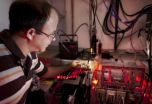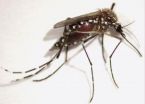(Press-News.org) Menlo Park, Calif. — In a study that could rewrite biology textbooks, scientists have found the first known living organism that incorporates arsenic into the working parts of its cells. What's more, the arsenic replaces phosphorus, an element long thought essential for life. The results, based on experiments at the Stanford Synchrotron Radiation Lightsource, were published online today in Science Express.
"It seems that this particular strain of bacteria has actually evolved in a way that it can use arsenic instead of phosphorus to grow and produce life," said SSRL Staff Scientist Sam Webb, who led the research at the Department of Energy's SLAC National Accelerator Laboratory. "Given that arsenic is usually toxic, this finding is particularly surprising."
Phosphorus forms part of the chemical backbone of DNA and RNA, the spiraling structures that carry genetic instructions for life. It is also a central component of ATP, which transports the chemical energy needed for metabolism within cells. Scientists have for decades thought that life could not survive without it.
But this was not the case for a strain of Halomonadaceae bacteria called GFAJ-1, found in an eastern California lake. Colonies of these bacteria flourished, as expected, when given a steady supply of phosphorus along with other necessities; yet when researchers replaced the phosphorus with arsenic, the colony continued to grow.
This suggested to Felisa Wolfe-Simon, a NASA research fellow and geobiologist in residence with the U.S. Geological Survey, that the bacteria were using the arsenic in place of phosphorus.
"We already knew that other microbes can 'breathe' arsenic, but it seemed these bacteria could be doing something new: building parts of themselves out of arsenic," said Wolfe-Simon, the paper's lead author. "To see if that was the case, we brought samples to SSRL. I came armed with the knowledge that the bacteria were doing something really weird, and I knew that SSRL beamline 2-3, in Sam's hands, could tell us more."
Wolfe-Simon's overall goal was to see if the arsenic was intimately associated with the bacterial cells or simply attached to the outside. The team swept SSRL's hair-thin X-ray beam across a sample of bacteria that had been bathed in high concentrations of arsenic. The interaction between the X-rays and the sample revealed where and how the arsenic wound up inside the bacterial cells.
"We saw similarities in the distribution of arsenic and the distribution of iron and zinc," two metals that indicate where an organism's cellular material is located, Wolfe-Simon said. In contrast, the distribution of phosphorus didn't match the distribution of the other elements, suggesting that arsenic took the place of phosphorus in the bacteria's cellular material.
To confirm this suspicion, the team conducted another experiment with the SSRL beam, this time in a spectroscopic mode, which identifies the types and locations of specific atoms. The experiment revealed that the arsenic atoms' nearest neighbors were oxygen and, at slightly longer distances, carbon. This pattern and the specific distances between the three types of atoms are a near-perfect match with the way phosphorus atoms bind to other atoms in strands of conventional DNA.
Wolfe-Simon said that these experiments strongly suggest that the bacteria aren't just absorbing arsenic, but incorporating it into their own beings as "biological arsenic."
Further bolstering this view, the arsenic did not take the form that would be expected if, for example, an organism were trying to remove the toxin from its system, and it was not surrounded by the types of molecules that an organism might use to render the arsenic inert, Webb said. The fact that it was attached to carbon and oxygen, he said, is "what we would expect if it were actually being used to create DNA, RNA or proteins." This would make the bacterium strain GFAJ-1 the first organism known to use arsenic in place of phosphorus for growth.
"In theory, this knowledge will rewrite biology textbooks," Wolfe-Simon said. "Whenever you hear about 'diversity' in biology, it always means metabolic diversity—diversity in what organisms breathe or what they oxidize, how they make a living. It's assumed that however diverse organisms may be, they're all made of the same elements: carbon, hydrogen, nitrogen, oxygen, phosphorus and sulfur. This type of bacterium is not. And that suggests that there may be a whole new world of organisms to explore."
Next, the team plans to investigate specific ways these bacteria might use arsenic in proteins, fats and nucleic acids such as DNA.
"To do this, we'll need a bigger sample," said Webb. "Felisa and her team are working to grow that now, and we're looking forward to further studying the details of this amazing organism at SSRL."
INFORMATION:
This research was conducted by Felisa Wolfe-Simon (NASA Astrobiology Institute, U.S. Geological Survey), Jodi Switzer Blum (U.S. Geological Survey), Thomas R. Kulp (U.S. Geological Survey), Gwyneth W. Gordon (Arizona State University), Shelley E. Hoeft (U.S. Geological Survey), Jennifer Pett-Ridge (Lawrence Livermore National Laboratory), John F. Stolz (Duquesne University), Samuel M. Webb (SSRL and SLAC), Peter K. Weber (Lawrence Livermore National Laboratory), Paul C.W. Davies (NASA Astrobiology Institute, Arizona State University), Ariel D. Anbar (NASA Astrobiology Institute, Arizona State University), and Ronald S. Oremland (U.S. Geological Survey).
SLAC National Accelerator Laboratory is a multi-program laboratory exploring frontier questions in photon science, astrophysics, particle physics and accelerator research. Located in Menlo Park, California, SLAC is operated by Stanford University for the U.S. Department of Energy Office of Science. The Stanford Synchrotron Radiation Lightsource at SLAC is a DOE Office of Science national user facility which provides synchrotron radiation for research in chemistry, biology, physics and materials science to more than a thousand users each year. The SSRL Structural Molecular Biology Program is supported by the DOE Office of Science and by the National Institutes of Health, National Center for Research Resources' Biomedical Technology Program.
Strange discovery: Bacteria built with arsenic
2010-12-04
ELSE PRESS RELEASES FROM THIS DATE:
The future of metabolic engineering -- designer molecules, cells and microorganisms
2010-12-04
Will we one day design and create molecules, cells and microorganisms that produce specific chemical products from simple, readily-available, inexpensive starting materials? Will the synthetic organic chemistry now used to produce pharmaceutical drugs, plastics and a host of other products eventually be surpassed by metabolic engineering as the mainstay of our chemical industries? Yes, according to Jay Keasling, chemical engineer and one of the world's foremost practitioners of metabolic engineering.
In a paper published in the journal Science titled "Manufacturing molecules ...
Broad coalition gathers to open the door for agriculture in international climate change negotiations
2010-12-04
CANCUN/MEXICO, 2 December 2010—Not content to see farming remain outside the international climate change negotiations under way in Mexico, a broad coalition of 17 organizations will bring together more than 400 policy makers, farmers, scientists, business leaders and development specialists on Saturday, December 4 to define steps for opening the door to agriculture within the next six months, permitting its full inclusion in both national action plans as well as the global climate agenda.
"Agriculture is a global crossroads where the issues of climate change, food security ...
'Less is more,' when it comes to sugary, high-caffeine energy drinks, researchers say
2010-12-04
WASHINGTON – Moderate consumption of so-called energy drinks can improve people's response time on a lab test measuring behavioral control, but those benefits disappear as people drink more of the beverage, according to a study published by the American Psychological Association.
With the growing popularity of energy drinks such as Red Bull, Monster, Burn and RockStar, especially among high school and college students, psychologists have been studying the effects of sugary, highly caffeinated drinks on young people. College students in particular have been using these ...
Personalized diets for elderly after hospitalization decreases mortality rates
2010-12-04
BEER-SHEVA, ISRAEL, December 2, 2010 -- Intense, individually tailored dietary treatment for acutely hospitalized elderly has a significant impact on mortality, according to a new study by researchers at Ben-Gurion University of the Negev.
The intervention study just published in the prestigious Journal of the American Geriatric Society showed higher death rates six months after discharge (11.6 percent) of the control group compared to the intervention group's death rate of 3.8 percent, which received intensive nutritional treatment designed and implemented by a registered ...
Light touch brightens nanotubes
2010-12-04
Rice University researchers have discovered a simple way to make carbon nanotubes shine brighter.
The Rice lab of researcher Bruce Weisman, a pioneer in nanotube spectroscopy, found that adding tiny amounts of ozone to batches of single-walled carbon nanotubes and exposing them to light decorates all the nanotubes with oxygen atoms and systematically changes their near-infrared fluorescence.
Chemical reactions on nanotube surfaces generally kill their limited natural fluorescence, Weisman said. But the new process actually enhances the intensity and shifts the wavelength. ...
From toxicity to life: Arsenic proves to be a building block
2010-12-04
LIVERMORE, Calif. - Arsenic - an element that triggers death for most Earthly life forms - is actually allowing for a bacterium to thrive and reproduce.
In a study that may prompt the rewriting of textbooks, a team of astrobiologists and chemists has found the first known living organism that can use arsenic in place of phosphorus in its major macromolecules. The new findings, published in the Dec. 2 Science Express, could redefine origins of life research and alter the way we describe life as we know it.
Oxygen, carbon, hydrogen, nitrogen, sulfur and phosphorous ...
Discovery by UC Riverside entomologists could shrink dengue-spreading mosquito population
2010-12-04
RIVERSIDE, Calif. – Each year, dengue fever infects as many as 100 million people while yellow fever is responsible for about 30,000 deaths worldwide. Both diseases are spread by infected female Aedes aegypti mosquitoes, which require vertebrate blood to produce eggs. The blood feeding and the egg development are tightly linked to how the mosquito transmits the disease-causing virus.
Now a team of entomologists at the University of California, Riverside has identified a microRNA (a short ribonucleic acid molecule) in female Aedes aegypti mosquitoes that when deactivated ...
E. coli outbreak in Connecticut caused by raw milk consumption
2010-12-04
Raw milk is consumed by an estimated 1-3 percent of the United States population. Raw milk and raw cheeses are responsible for almost 70 percent of reported dairy outbreaks. On July 16, 2008, the Connecticut Department of Public Health identified two unrelated children who had experienced hemolytic uremic syndrome after consuming raw milk from the same farm. The authors investigated the situation further and found more cases of people affected by raw milk from the same farm. The details of their study are chronicled in the Dec. 15 issue of Clinical Infectious Diseases, ...
NIH study suggests that early detection is possible for prion diseases
2010-12-04
A fast test to diagnose fatal brain conditions such as mad cow disease in cattle and Creutzfeldt-Jakob disease in humans could be on the horizon, according to a new study from National Institutes of Health scientists. Researchers at NIH's National Institute of Allergy and Infectious Diseases (NIAID) have developed a highly sensitive and rapid new method to detect and measure infectious agents called prions that cause these diseases.
"Although relatively rare in humans and other animals, prion diseases are devastating to those infected and can have huge economic impacts," ...
New discovery prevents symptoms of rare genetic disorder
2010-12-04
The research was led by Dr. Matthew Ellinwood, a veterinarian and animal science professor at Iowa State University, in collaboration with Dr. Patricia Dickson at the Harbor-UCLA Medical Center, with colleagues at the Iowa State College of Veterinary Medicine, the University of Tennessee, St. Louis University and the University of Pennsylvania. Their work was published in the AAAS journal Science Translational Medicine.
The research focused on a disorder called mucopolysaccharidosis type I, or MPS I, which is caused by the lack of a key enzyme that breaks down substances ...


